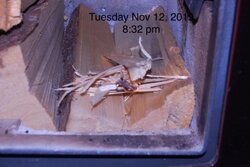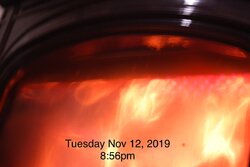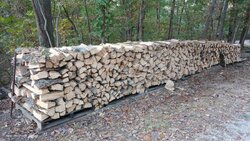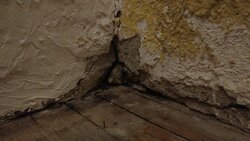Highbeam
Minister of Fire
Still learning.
Last night I reloaded by first opening the bypass. Wait about 1 or 2 min, then crack the door slightly to allow the chamber to equalize. Then open door (no smoke spillover), stir coals with rod, reload box about 2/3rds. Close door and engage cat since it was still slightly in the active zone.
Fire takes off and I let it go on high for 5 or 10 min. Lots of flame in the box and the top temp on the Princess Insert gets to about 600. I step out side and smell what seems to be like a burning plastic odor. Look up and there is some dark or slightly black smoke (it was pretty windy). Come back inside and turn down thermostat to medium to quiet the flames. Go back out and shortly thereafter the smoke is now white and then diminishes.
Was that smell just burning off some creosote from inside the box. I did notice some flaky black stuff on the sides and rear, and the door frame (inside of knife edge) is pretty gunked up.
No smell inside, BKVP is correct that there is almost no odor from breaking in the new paint on this 3 week old unit. What say ye?
There is only so much that the cat can eat. It can be overwhelmed and pass smoke during early stages of combustion and at high stat settings. Fortunately, you shouldn’t need to spend much time at full throttle.
The stink from the exhaust of a cat stove is odd. Plastics are hydrocarbons and wood gas is a hydrocarbon, it is possible that they smell similar when burning.
Last edited:








 Seriously, the big thing for me with the thermostat would be that it would automatically open up the air on the coals and keep the heat output up at the end of the load. Even with the small Keystone box in this leaky house, one of us is usually around to open up the air on the coals for the last couple hours of the burn and keep the heat pumping on those really cold days. We make it through the night without room temp dropping but a degree or two unless it's single digits with a howling wind.
Seriously, the big thing for me with the thermostat would be that it would automatically open up the air on the coals and keep the heat output up at the end of the load. Even with the small Keystone box in this leaky house, one of us is usually around to open up the air on the coals for the last couple hours of the burn and keep the heat pumping on those really cold days. We make it through the night without room temp dropping but a degree or two unless it's single digits with a howling wind. I knew about the seam at the bottom of the wall board, but not the gaping hole in the corner, had some crap in front of it forever and forgot it was there. Fixing it in the next couple days. With this place a little tighter, even brutal cold won't be a match for my little box.
I knew about the seam at the bottom of the wall board, but not the gaping hole in the corner, had some crap in front of it forever and forgot it was there. Fixing it in the next couple days. With this place a little tighter, even brutal cold won't be a match for my little box. 
